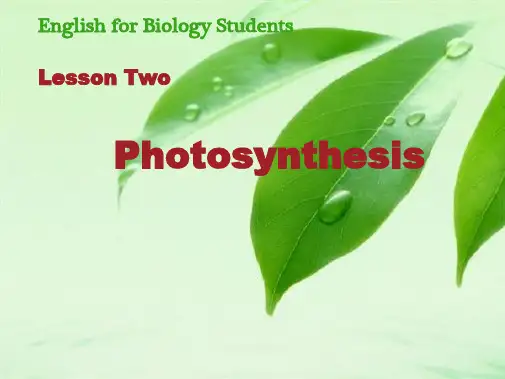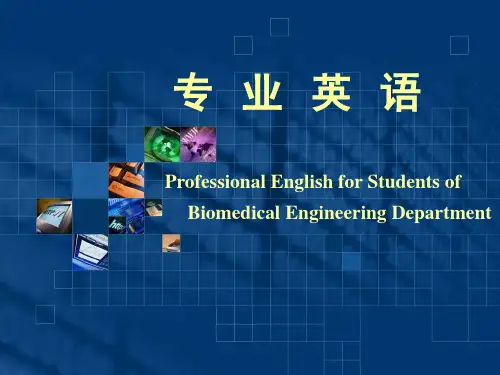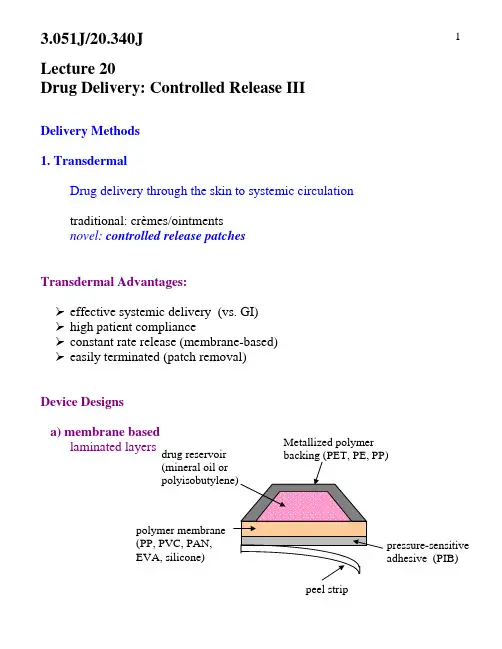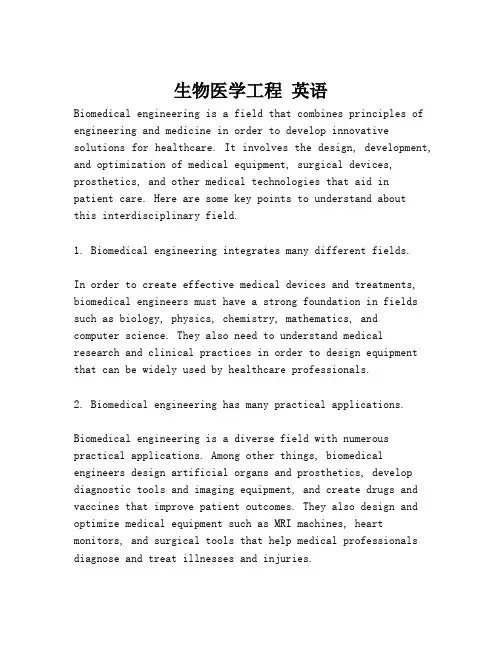生物医学工程专业英语精品PPT课件
- 格式:pptx
- 大小:872.71 KB
- 文档页数:33

![生物医学工程专业英语 Unit08[69页]](https://uimg.taocdn.com/595641b0aeaad1f346933fe6.webp)




![生物医学工程专业英语 Unit10[66页]](https://uimg.taocdn.com/c4b0d9a3c8d376eeaeaa31e6.webp)

Lecture 20Drug Delivery: Controlled Release IIIDelivery Methods1. TransdermalDrug delivery through the skin to systemic circulationtraditional: crèmes/ointmentsnovel: controlled release patchesTransdermal Advantages:¾effective systemic delivery (vs. GI)¾high patient compliance¾constant rate release (membrane-based)¾easily terminated (patch removal)Device Designsa) membrane basedMetallized polymerlaminated layersdrug reservoir(mineral oil orpolymer membrane(PP, PVC, PAN, pressure-sensitiveEVA, silicone) adhesive (PIB)peel strip⇒ Release rate constant (rate-limited by diffusion through membrane) b) monolithic patchMetallized polymer drug reservoir (polymer)pressure-sensitive adhesive (PIB)⇒ C 0 >> C S Drug dissolution in polymer matrix controls release rateDisadvantages to Transdermal Delivery a) low skin permeability to drugsstratum corneum ~10-15 µbilayers) epidermis ~50-100 µm(living cells, nerves)dermis: (cells, nerves, vessels)Stratum corneum is hydrophobic – limits drug penetrationEpidermis is hydrophilicMain entry to vasculature via pores (small % of surface)Methods to enhance permeability:i) penetration enhancers “shield” interactions, i.e., amphiphiles(traditional crèmes: H2O/oil + lipids)ii) iontophoresis – mild electrical current (0.5mA/cm2) applied to skin atdelivery site increases penetration rate of charged therapeutic agentsex., Vyteris lidocainetransdermal deliveryE-field drives chargeddrugs thru skin iii) microneedles – penetrate the stratum corneum or epidermisex., 3M hollow plasticiv) ultrasound needle system for vaccinedelivery (L>100 µm)b) drugs bind to skin – desorption becomes rate-limiting stepc) allergic reaction—triggered by adhesive2. Colloidal Drug Delivery vehiclesSpherical particles of polymers or lipids with dispersed, adsorbed,covalently bound or encapsulated therapeutic agentsnanospheres/ nanocapsules/liposomes microspheres microcapsulesAdministration Routesa) Oralreleased drug is absorbed in small intestinephagocytosis of delivery vehicles (dia. < 10µm) in small intestine via M-cells (lymphatic tissue) of Peyer’s patchesAdvantages: - patient acceptance-convenientIssues: - poor uptake—rapidly metabolized-chemical instability in GI tractb) Subcutaneous injectionphagocytosis, deposition in lymph nodes (dia. < 10µm) particles collect at injection site (dia. > 30µm) Advantages: - patient can administer- does not require digestion (nauseated patients) Issues: - poor distribution to target-local tissue irritation/toxicityc) Intravenous administrationsystemic circulation for dia. < 4 µm (smallest capillary) interaction with reticular endothelial system (RES)phagocytosis in liver, spleen, lungs, lymph nodes Advantages: - effective systemic treatment- does not require digestionIssues: - short circulation times-low penetration of endothelial lining of vasculature(requires dia. < 5nm)Types of Vehiclesa) Nanospheres (10nm-1µm)/microspheres (1-10µm)Drug is dissolved or dispersed in a polymer matrix, or adsorbed topolymer bead surfaceProcessing Methods: Emulsion-basedEmulsion polymerization with drug dispersion-growingoligomerGrowing polymer chains are immiscible in solvent- Micelles form, incorporating the polymer and drug- Can be aqueous or organic based synthesis, depending onpolymer and therapeutic agent- Examples: polyacrylamide/antigen vaccines, biodegradablepoly(alkyl cyanoacrylate)/doxorubicin chemotherapeuticsPMMA/antigen vaccines (influenza, HIV)Emulsification of polymer and drug- Preformed polymer dissolved in volatile organic solvent (ex., chloroform, methylene chloride, ethyl acetate)- Organic solution is mechanically dispersed in aqueous phase containing surfactant or stabilizer, forming an emulsion- Drug incorporated in organic (if lipophilic) or aqueous(if hydrophilic) phase, or later adsorbed- Nanoparticles recovered by evaporation of organic solvent or precipitation through dilution with water- Matrices: PLA, PGA, PLGA, PCL (polycaprolactone), PHB(poly(hydroxybutyrate)), polyorthoesters (acid sensitive) Influences on Nanosphere Release/Degradation Rate•Molecular weight•Crystallinity•Diameter•Water permeability•T g•pH Sensitivityb) Nanocapsules/microcapsulesDrug or drug dispersion in matrix is enclosed by a polymermembrane/outer layerWhat is the advantage ofthis approach?Processing Methods:Interfacial polymerization of polyamides- Emulsion formed with acid dichloride monomer & drug indispersed oil phase, diamine monomer in water phase- monomers migrate to oil/water interface and polymerize bycondensation reaction, encapsulating the drugNH2-R-NH2 + R’(COCl)2 → (ClCO)-R’-CONH-R-NH2 + HClamide bond-trichlorides and triamines added as crosslinking agentsInterfacial Coacervation- encapsulating polymer dissolved in organic phase- drug particles are added to organic solution- a second polymer immiscible with the first (or othernonsolvent) is added to suspension, inducing phase separation - encapsulating polymer precipitates onto the drug particlesurfaces, forming a capsuledrug 2nd polymer/particles nonsolventadded addedComplex Coacervation- two solutions of oppositely charged polyelectrolytes areprepared, one containing drug dispersion- addition of second polyelectrolyte to first results incomplexation and precipation onto drug particles- Examples: gelatin (-) and gum arabic (+), alginate (-) and chitosan (+)Polyelectrolyte Multilayers (recent)- alternate adsorption of polyanions and polycations onto drug-containing particlesc) LiposomesDrug encapsulated in spherical phospholipid bilayers/vesiclesProcessing Method:- Water-in-oil emulsion formed of aqueous drug solution,amphiphiles, and volatile organic phase- Evaporation of organic solvent—lipids deposit around aqueousmicrodroplets, forming vesicles- Ultrasound conversion to unilamellar vesicles- nanofiltration to control size distributionsonicationTherapeutic Agents:- bacterial, viral, parasitic antigens (vaccines)- DNA, DNA fragments (gene therapy)agents-chemotherapeuticTargeted Therapy Mechanisms:- liposome collection in RES (lymph nodes, liver, lungs)cancersofmetastaticCommonsites-incorporation of lipid-bound MAbs for targeting chemotherapy ⇒ “MAGIC BULLET”Ex. MAb for mouse pulmonary endothelial cell surface proteinsused to target metastatic lung cancer-Incorporation of lipid-bound peptidesReceptor-mediated endocytosis- Engineer liposome structure to mimic red blood cell membrane Drug-targeting to regions of high capillarity (ex., tumors,inflammation sites)vaccines-DNAImmunogen or antigen encoded in DNA, cells take up innucleusIn clinical trials: cystic fibrosis, melanomaLiposome Advantages:-low toxicity-uptake by endocytosis (can fuse with cell wall)- high transfection efficiency (gene therapy)Issues:- short circulation time due to phagocytosis ( Strategies to enhance circulation time:•decrease size• increase bilayer rigidity• incorporate PEO-amphiphiles⇒-liposome instability• poor mechanical stability• phospholipids easily hydrolyzed (ester linkages)⇒ drug leachingStrategy to enhance stability:polymer vesicles from amphiphilic block copolymers⇒“Polymersomes” What is a disadvantage of this strategy?- denaturation of therapeutic proteins•in processing: shear forces, solvents, T•in vivo: secondary interactions, pH variationsExample Liposome ProductsProduct Agent UseAmBisomes amphotericin B systemic fungal infectionDOX-SL doxorubicin chemotherapysarcoma DaunoXome daunorubicin Karposi’shepatitis A vaccineEpaxal-Berna inactive3. Externally Controlled Implantable PumpsEnable doctor/patient control of:•Delivery dosage•Flow rate•Dosage scheduleExamplesSynchroMed Infusion System (Medtronic)-percutaneously refillable reservoir-lithium battery-operated peristaltic pump-magnetic telemetry link for computer control-FDA approved for chemotherapeutic agents, morphine sulfate Programmable Implantable Medical System (PIMS) (Johns-Hopkins)-percutaneously refillable reservoir-solenoid-based pump-being developed for insulin delivery for diabetesPhoto of PIMS removed for copyright reasons.ReferencesEncyclopedia of controlled drug delivery vol. 1, E. Mathiowitz, ed., John Wiley & Sons, NY, 1999. Encyclopedia of controlled drug delivery vol. 2, E. Mathiowitz, ed., John Wiley & Sons, NY, 1999. Biomaterials Science: An introduction to materials in medicine, B.D. Ratner et al., eds., Academic Press, NY 1996.。


生物医学工程英语Biomedical engineering is a field that combines principles of engineering and medicine in order to develop innovative solutions for healthcare. It involves the design, development, and optimization of medical equipment, surgical devices, prosthetics, and other medical technologies that aid inpatient care. Here are some key points to understand aboutthis interdisciplinary field.1. Biomedical engineering integrates many different fields.In order to create effective medical devices and treatments, biomedical engineers must have a strong foundation in fields such as biology, physics, chemistry, mathematics, andcomputer science. They also need to understand medical research and clinical practices in order to design equipment that can be widely used by healthcare professionals.2. Biomedical engineering has many practical applications.Biomedical engineering is a diverse field with numerous practical applications. Among other things, biomedical engineers design artificial organs and prosthetics, develop diagnostic tools and imaging equipment, and create drugs and vaccines that improve patient outcomes. They also design and optimize medical equipment such as MRI machines, heart monitors, and surgical tools that help medical professionals diagnose and treat illnesses and injuries.3. Biomedical engineering research is constantly pushing the field forward.Scientists and engineers in the field of biomedical engineering are constantly working to develop new medical technologies and strategies. Their work has led to manyground-breaking innovations, such as pacemakers, bionic limbs, and complex imaging technologies that enable doctors tobetter understand the human body.4. Biomedical engineering has a real-world impact on patient health.Perhaps the most important aspect of biomedical engineeringis that it has a direct impact on patient health. By developing new medical technologies and treatments,biomedical engineers are able to improve patient outcomes and quality of life. For example, prosthetics can enable people with disabilities to live full and active lives, and MRI machines and other diagnostic tools can help doctors detect and treat conditions before they become life-threatening.Overall, biomedical engineering is a dynamic and importantfield that has the potential to make a significant impact on people's health and well-being. By combining a deep understanding of medicine with the technical skills of engineering, biomedical engineers are creating innovative solutions to some of the most pressing challenges facing the healthcare industry today.。
